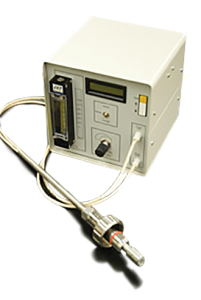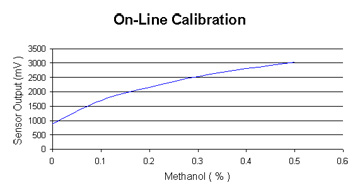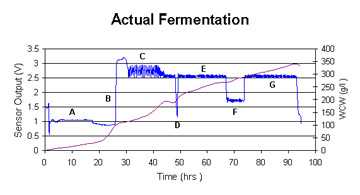Raven Biotech’s Methanol Sensor allows you to measure and control methanol levels precisely so that you can consistently achieve high product yield. The detector element incorporates a semiconductor chip with a sintered tin oxide film which detects the presence of a combustible vapour with an increase in electrical conductivity when the reducing gas is adsorbed on the sintered surface. This type of detector is widely used in gas measurement and is intrinsically very stable. Methanol, dissolved in the culture medium, diffuses across the probe membrane and is picked up by a stream of clean dry air, which carries it to the detector. The output of the Sensor is a function of the concentration of methanol in the culture medium as shown in Figure 1. The Sensor is not specific for methanol, however, under aerobic conditions methanol is usually the only combustible vapour present. Pichia cultures, which become oxygen limited can also produce ethanol which is also detected. The ethanol is consumed when adequate dissolved oxygen is re-established. Pichia cultures also produce ethanol when a high level of glucose is present, a phenomenon known as the Crabtree effect.


Figure 1
Typical voltage output of sensor on-line calibration prior to the induction phase of fermentation.

Figure 2
Methanol sensor output in millivolts during Pichia pastoris fermentation.
(A) Batch phase – the baseline voltage corresponds to a methanol free signal followed by an on-line calibration.
(B) Discrete 0.1% doses of methanol were added up to 0.5% for calibration and to initiate induction. The methanol was then allowed to be consumed, dropping to the user defined set point
of to 0.3% methanol (from the calibration equal to 2.6 volts).
(C) With the methanol pump set to deliver 0.6 mls/min, automatic on/off control is established by the Sensor.
(D) The base line voltage was rapidly verified by disconnecting the probe tubing and connecting the inlet/outlet fittings on the Sensor unit directly thereby bypassing the probe.
(E) The system is returned to stand alone control at 0.3% methanol.
(F) The set point was changed to 0.1% methanol (to observe the response time).
(G) The setpoint was readjusted to 0.3% and maintained throughout the remainder of the culture.

Figure 3
Schematic of Pichia pastoris
Fermentation System with
Methanol Sensor
